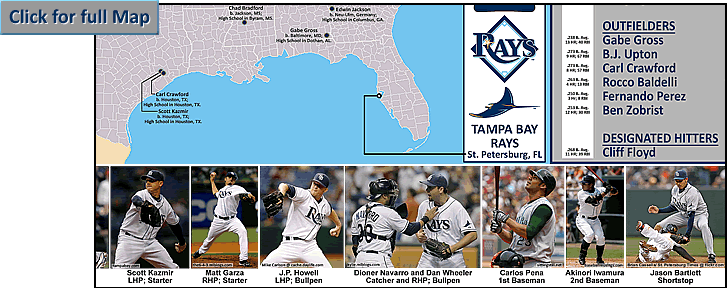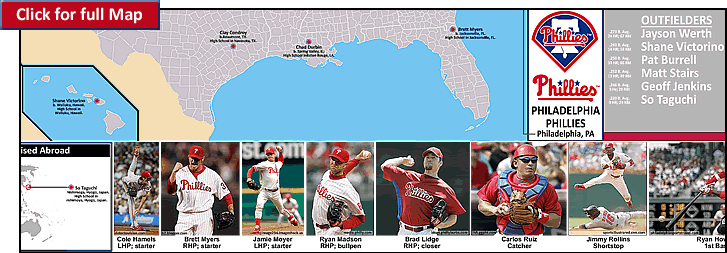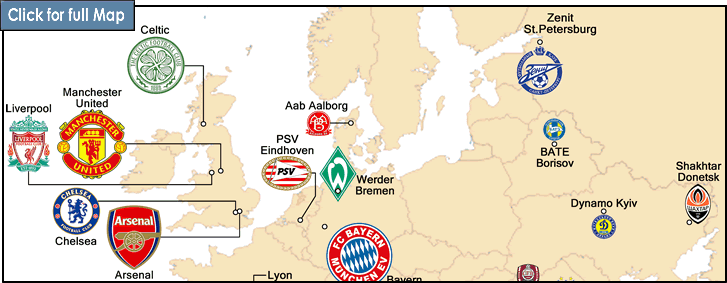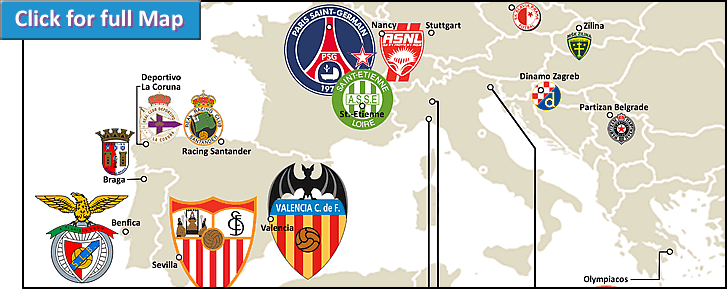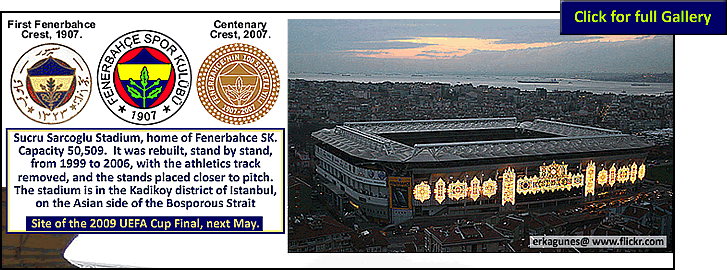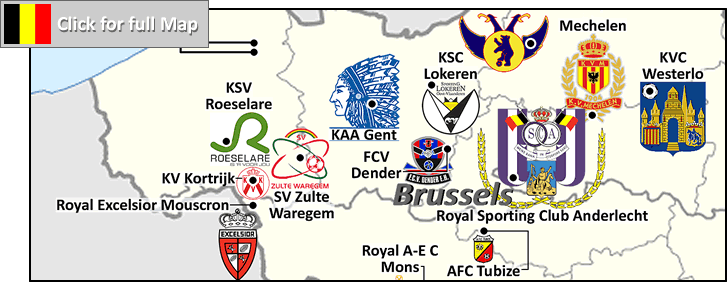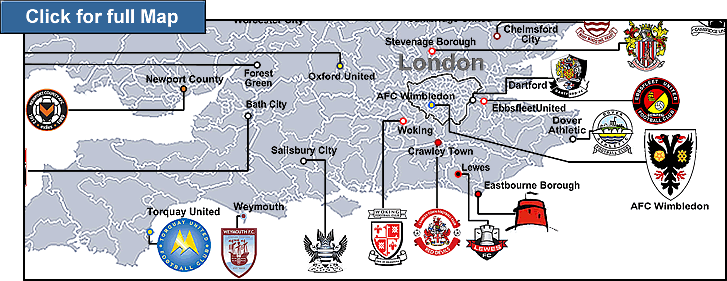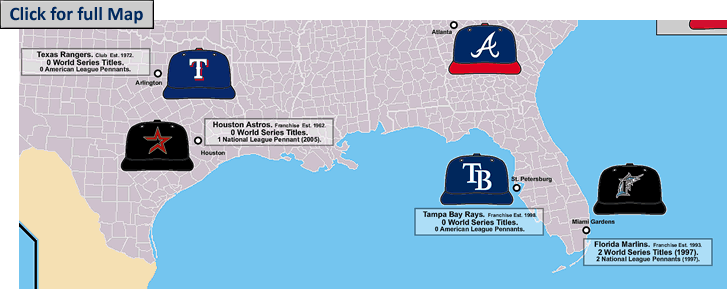
…
…
(Note: my most current map of MLB teams an be found at the following, category: Baseball > Paid-Attendance.)
…
A little while back, I got a question asking if I had made, or knew of, a chart showing all the franchise shifts in Major League Baseball. So when I was making this map, I decided to add a table showing all the franchise shifts in MLB during the 20th and 21st Centuries. No bells and whistles like colors and logos, though (maybe I’ll do one like that in the future), just the ball clubs’ names, years in existance, franchise shifts, and titles.
I skipped the 19th Century franchise shifts…there were a whole lot of fly-by-night ball clubs in the formative years of the National League. But for the record, here are the defunct 19th Century National League ball clubs that won NL Pennants…Providence Grays, 2 NL Pennants (1879 and 1884). Detroit Wolverines, 1 NL Pennant (1887). Baltimore Orioles (I), 3 (consecutive) NL Pennants (1894-1896). For the complete list of National league Pennant winners from 1876 to 1968 (the extra tier of playoffs began in 1969), {Click here}.
The National League was founded in 1876. In total, there were 27 National League franchises from the 19th century {see this}. No NL ball club has folded since 1899. The 8 franchises that survived the NL’s contraction from 12 teams to 8 teams, after the 1899 season, are still in the National League today {see this}, although the Chicago Cubs are the only NL ball club that has remained in the same city, uninterrupted, since 1876. I know this gets confusing, but the Chicago Cubs were originally called the Chicago White Stockings (I). [This ball club had no connection to the American League franchise formed a quarter-century later.] It wasn’t until 1902, and two name changes (the Chicago Colts, then the Chicago Orphans), that the NL Chicago ball club officially became the Chicago Cubs.
The Atlanta Braves’ franchise also dates back to 1876; this ball club began as the Boston Red Stockings (aka Red Caps). [Again, this National League Boston club had no connection with that American League franchise formed a quarter-century later who later became the Boston Red Sox.] The Braves’ franchise has went through 10 name changes and 3 cities.
The third and fourth oldest National League franchises still in existence both date back to 1883. They are the Philadelphia Phillies (originally known as the Philadelphia Quakers) and the San Francisco Giants (originally the New York Gothams; but known as the New York Giants from 1885 to 1957).
The fifth oldest NL franchise is the Pittsburgh Pirates, who joined the National League as Allegheny (no city name and no plural, initially), in 1887. The club had left the rival late 19th Century major league called the American Association (which existed from 1882 to 1891; see this). The ball club got their present name after the Philadelphia Athletics of the AA accused them of piracy, in acquiring one of Philadelphia’s best players. The Pittsburgh club took the pejorative and used it to their advantage, renaming themselves the Pittsburgh Pirates in 1891. Not incidentally, this affair was one of the contributing factors which led to the demise of the American Association, the next year.
The sixth and seventh oldest NL franchises both date to 1890. They are the Cincinnati Reds and the Los Angeles Dodgers. The Reds were not connected with the two Cincinnati Red Stockings ball clubs, the first being the first nationally successful pro baseball club (from 1866 to 1870 and pre-dating the National League…see this). The latter Cincinnati Red Stockings were a founding member of the National League in 1876, but were expelled from the league in 1880 for serving beer at games, and for violating ballpark lease arrangements. The present-day Cincinnati Reds joined the National League in 1890, leaving the American Association (see this time-line of the American Association). Another club left the AA to join the NL in 1890…the Brooklyn Bridegrooms. This club went through 2 name changes prior to the endearingly anachronistic Bridegrooms moniker, and 4 more name changes before they officially became the Brooklyn Dodgers (in 1932). They were known in the period from approximately 1899 to 1910, bizarrely, as the Brooklyn Superbas (after a popular acrobatic troupe of the time). By this time, the nickname of Trolley Dodgers had gained currency for the Brooklyn club…the story goes that their ball park then was at the confluence of several mass transit lines, so the fans were literally dodging trolleys and streetcars to get to the park. But from 1914 to 1931, the club was officially known as the Brooklyn Robins, after their manager Wilbert “Uncle Robbie” Robinson. However, fans and sportswriters alike used the Dodgers moniker interchangeably in describing the hapless, yet beloved ”Bums” of Brooklyn. Of course, the Brooklyn Dodgers toiled in futility, then later in agonizing runners-up status (with 6 World Series losses, the last 5 all to the New York Yankees, between 1941 and 1953), until they finally won the World Series in 1955. The underdog borough of Brooklyn had little time to revel in its new status as champions. Two years later the management of the Brooklyn Dodgers, succumbing to the lure of free, soon-to-be valuable land to build a new stadium, broke the heart of the borough by moving clear across the country to Los Angeles, California.
The eighth oldest National League ball club is the St. Louis Cardinals. They were yet another club that arrived in the National League via the American Association. This occurred in 1892, after the AA folded. They were first known as the St. Louis Brown Stockings. In 1899, they called themselves the St. Louis Perfectos. In 1900, the club changed their name to the St. Louis Cardinals, but not after the bird, but the shade of red. In the 19th Century, it was traditional for many ball clubs to name themselves after the color of their socks, and the term cardinal was a more common name for a shade of red back then than it is now. The Cardinals in fact did not display ornithological iconography until 1922 {see this}.
The American League began in 1901. All 8 of the founding franchises still exist, but only 4 are still in the same city…the Chicago White Sox (who began as simply as the White Stockings), the Cleveland Indians (who began as the Cleveland Blues), the Detroit Tigers, and the Boston Red Sox (this ball club had no official nickname until they adopted the Red Sox name in 1908). For the complete list of American League franchises, names, and shifts, {Click here}.
For the complete list of AL Pennant winners, {Click here}.
The map shows all 30 current MLB clubs, with each club’s primary ball cap. On the main map, titles are listed for the city the ball club plays in now. Total franchise titles are listed in the chart at the bottom.
As with regards to the dots showing each ball club’s geographic placement… I listed the actual city, town, or metropolitan borough the ball club plays in (ie, the New York Yankees play in The Bronx; the Florida Marlins play 15 miles north of downtown Miami, in Miami Gardens, etc.).
Thanks to the Sports E-cyclopedia site, for the baseball hat icons. http://www.sportsecyclopedia.com/.
Thanks to all the nameless contributors to the invaluable MLB pages which are on Wikipedia.


